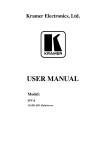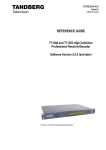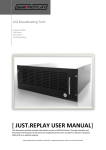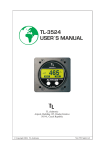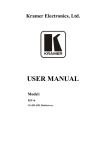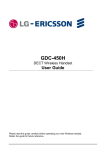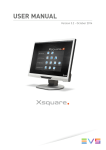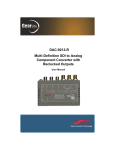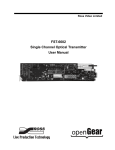Download USER MANUAL - Kramer Electronics
Transcript
K R A ME R E LE CT R O N IC S L TD .
USER MANUAL
MODEL:
MV-5
5 Channel Multiviewer
P/N: 2900-300134 Rev 4
Contents
1
Introduction
1
2
2.1
2.2
2.3
2.4
3
Getting Started
Achieving the Best Performance
Safety Instructions
Recycling Kramer Products
Accessory to Medical Equipment (IEC 60601-1)
Overview
2
2
2
3
3
4
4
Defining the MV-5 5 Channel Multiviewer
5
Installing in a Rack
10
6
6.1
6.2
6.3
7
7.1
7.2
Connecting the MV-5 5 Channel Multiviewer
Connecting to the MV-5 Using the RS-232 Connection
Connecting to the MV-5 Using the RS-485 Connection
Connecting to the MV-5 Using Ethernet
Configuring and Operating the MV-5 Locally
Configuring the MV-5 Using the Menu
Operating the MV-5 Using the Front Panel Buttons
11
14
14
14
18
20
30
8
8.1
8.2
8.3
8.4
9
Configuring and Operating the MV-5 Remotely
The Multiviewer Main Window
The Menu Bar
The Quick Access Toolbar
Using the MV-5 Multiviewer Software
Upgrading the Firmware
39
40
41
47
49
56
10
Technical Specifications
57
11
Default Communication Parameters
58
12
Default EDID
59
13
13.1
13.2
Kramer Protocol 3000
Kramer Protocol 3000 Syntax
Kramer Protocol 3000 Commands
60
60
63
6
Figures
Figure 1: MV-5 5 Channel Multiviewer Front Panel
Figure 2: MV-5 5 Channel Multiviewer Rear Panel
Figure 3: Connecting the MV-5 5 Channel Multiviewer
Figure 4: Local Area Connection Properties Window
Figure 5: Internet Protocol Version 4 Properties Window
Figure 6: Internet Protocol Properties Window
Figure 7: Image Position and Scaling Example
Figure 8: MV-5 Controller Software Main Window
Figure 9: Background Color Window
Figure 10: Image Properties Window
Figure 11: Advanced Properties Window
Figure 12: Device Details Window
Figure 13: About MV-5 Window
Figure 14: Quick Access Toolbar
Figure 15: Quick Access Toolbar Icons
6
8
12
15
16
17
32
40
42
43
44
46
47
47
47
MV-5 - Contents
i
Figure 16: Connection Method Window
Figure 17: Windows Position
Figure 18: Switch Buttons
Figure 19: Layer Order
Figure 20: Switching an Input to a Window
Figure 21: Windows Setup Window
Figure 22: Input Button Properties Window
ii
48
49
50
51
52
53
55
MV-5 - Introduction
1
Introduction
Welcome to Kramer Electronics! Since 1981, Kramer Electronics has been
providing a world of unique, creative, and affordable solutions to the vast range of
problems that confront video, audio, presentation, and broadcasting professionals
on a daily basis. In recent years, we have redesigned and upgraded most of our
line, making the best even better!
Our 1,000-plus different models now appear in 11 groups that are clearly defined
by function: GROUP 1: Distribution Amplifiers; GROUP 2: Switchers and Routers;
GROUP 3: Control Systems; GROUP 4: Format/Standards Converters; GROUP 5:
Range Extenders and Repeaters; GROUP 6: Specialty AV Products; GROUP 7:
Scan Converters and Scalers; GROUP 8: Cables and Connectors; GROUP 9:
Room Connectivity; GROUP 10: Accessories and Rack Adapters and GROUP 11:
Sierra Video Products.
Congratulations on purchasing your Kramer MV-5 5 Channel Multiviewer which is
ideal for:
Professional broadcasting and production studios
Presentation applications
Post production
MV-5 - Introduction
1
2
Getting Started
We recommend that you:
Unpack the equipment carefully and save the original box and packaging
materials for possible future shipment
i
2.1
Review the contents of this user manual
Go to http://www.kramerelectronics.com/support/product_downloads.asp
to check for up-to-date user manuals, application programs, and to check if
firmware upgrades are available (where appropriate).
Achieving the Best Performance
To achieve the best performance:
Use only good quality connection cables (we recommend Kramer highperformance, high-resolution cables) to avoid interference, deterioration in
signal quality due to poor matching, and elevated noise levels (often
associated with low quality cables)
Do not secure the cables in tight bundles or roll the slack into tight coils
Avoid interference from neighboring electrical appliances that may adversely
influence signal quality
!
2.2
This equipment is to be used only inside a building. It may only be
connected to other equipment that is installed inside a building.
Safety Instructions
!
2
Position your MV-5 away from moisture, excessive sunlight and dust
Caution:
There are no operator serviceable parts inside the unit
Warning:
Use only the power cord that is supplied with the unit
Warning:
Do not open the unit. High voltages can cause
electrical shock! Servicing by qualified personnel only
Warning:
Disconnect the power and unplug the unit from the wall
before installing
MV-5 - Getting Started
2.3
Recycling Kramer Products
The Waste Electrical and Electronic Equipment (WEEE) Directive 2002/96/EC
aims to reduce the amount of WEEE sent for disposal to landfill or incineration by
requiring it to be collected and recycled. To comply with the WEEE Directive,
Kramer Electronics has made arrangements with the European Advanced
Recycling Network (EARN) and will cover any costs of treatment, recycling and
recovery of waste Kramer Electronics branded equipment on arrival at the EARN
facility. For details of Kramer’s recycling arrangements in your particular country
go to our recycling pages at http://www.kramerelectronics.com/support/recycling/.
2.4
Accessory to Medical Equipment (IEC 60601-1)
In the modern medical environment remote access is essential, for example, to
transfer clinical data between doctors and to train to medical students. The MV-5 is
certified according to the IEC 60601-1-2, Clause 2.1.3, Medical Electrical
Equipment, Part 1: General Requirements for EMC standard which is required
when accessory devices are used at locations where medical personnel and
patients are present.
The MV-5 constitutes an optional component that can be considered necessary
and suitable as part of medical equipment or for use as part of a medical system to
provide real time simultaneous video feeds to those present at the local medical
environment and at remote locations. In this environment, the MV-5 can be added
to the system ONLY if the connecting equipment has been evaluated and meets
the IEC 60601-1-2 EMC standards. Note, that when attaching accessory devices
to a digital or analog interface, they must comply with the IEC standard for which
they are used: EMC Standard (IEC 60601-1-2), Information Technology equipment
(IEC 60950-1 (2ed)).
MV-5 - Getting Started
3
3
Overview
The MV-5 is a versatile, high-performance video and graphic multi-viewer for DVI
signals, SD and HD analog signals up to 1920x1200@60Hz, and SDI signals up to
3G HD-SDI. The device can window up to four sources (plus a background) in any
layout and output the image as SDI, DVI, component and composite video signals.
Both preprogrammed and customizable screen division is supported.
In particular, the MV-5 has:
16 inputs with rapid selection and switching
An input bandwidth of up to 3Gbps which supports standard definition, high
definition and 3G high definition serial digital video signals
SMPTE 259M, 292M and 424M input compliance and support for data rates
of 270Mbps, 1.4835Gbps, 1.485Gbps, 2.967Gbps and 2.97Gbps
Input-cable equalization up to 350m (1150ft) for SD signals, 140m (459ft) for
1.5GHz HD signals, and 120m (394ft) for 3GHz HD signals
SD means an NTSC or PAL compatible video format, consisting of 480 (for NTSC) or
576 (for PAL) lines of interlaced video. HD means a video format consisting of 720
active lines of progressive video or 1080 lines of progressive or interlaced video
Any format to any format cross-conversion
Any Standard to any standard cross-conversion
HDCP support on DVI inputs/outputs
Four independent chroma-key engines for each image layer
Window and image scaling, zooming (up to 1000%), and aspect ratio control
Independent layer transparency control
Brightness, contrast, color and sharpness control
Window or input label insertion
Multi-video output formats; SD-SDI (259M), HD-SDI (292M) and 3G HD-SDI
(SMPTE 424M), HDMI, HD, SD, analog and composite
Kramer re-Klocking™ and equalization on each input—rebuilds the digital
signal to travel longer distances
4
MV-5 - Overview
Flexible control options; front panel with menu LCD, Ethernet and RS-232
Screen handling buttons; freeze, size, position
16 user-definable screen layouts
A front panel lock button
The MV-5 is housed in a 19" 2U rack mountable enclosure and is fed from a
100-240 VAC universal switching power supply.
You can control the MV-5 using the front panel buttons, or remotely via:
RS-232/RS-485 serial commands transmitted by a serial controller (see
Section 6.1 and Section 6.2)
A PC connected to the Ethernet port on the device via a LAN using the
control software (see Section 6.3)
MV-5 - Overview
5
4
Defining the MV-5 5 Channel Multiviewer
6
Figure 1 defines the front panel of the MV-5.
MV-5 – Defining the MV-5 5 Channel Multiviewer
Figure 1: MV-5 5 Channel Multiviewer Front Panel
#
Feature
Function
1
DVI INPUTS 1~4 Buttons
Press to select one of the DVI sources
2
WINDOWS 1~4 Buttons
Press to make one of the windows the upper-most window (see Section 7.2.1). The order of the other
windows is not changed
3
SDI INPUTS 1~4 Buttons
Press to select one of the SDI sources
4
FREEZE Button
Press to freeze and release the selected window signal
5
LCD 2 Line x 20 Character
Text Display
Displays the current configuration or menu
6
SAVE ASPECT Button
Press to turn on the Save Aspect mode whereby the window or image aspect is locked during size
adjustments (see Section 7.2.1)
MV-5 – Defining the MV-5 5 Channel Multiviewer
#
Feature
Function
7
LAYERS DEF Button
Press to set the order of priority of the window layers
8
MENU Button
Press to enter the configuration menu. When the menu is displayed, press to exit one level (see
Section 7.1)
9
ENTER Navigation Pad
Press Enter to enter the sub-menu or accept a parameter value. Press and hold together with the
arrow keys to scroll rapidly through parameter values (see Section 7.1)
10
PANEL LOCK Button
Press and hold to lock the front panel buttons. Press and hold again to unlock the front panel buttons
(see Section 7.2.8)
11
ANALOG HD INPUTS 1~4
Buttons
Press to select one of the analog HD sources
12
ANALOG SD INPUTS 1~4
Buttons
Press to select one of the analog SD sources
13
CROP PVW Button
Press to display a full screen preview of the selected window image. Press when zooming to show the
mask of the cropped image
14
15
16
WINDOW
Buttons
ZOOMED
Buttons
SIZE Button
Press to adjust the size of the selected window (see Section 7.2.3)
POSITION
Button
Press to adjust the position of the selected window
SIZE Button
Press to adjust the image size within the selected window, that is, the degree of zoom
POSITION
Button
Press to adjust the image position within the selected window, that is, the image panorama
WINDOW SELECT Button
Press to step through the windows to select an active window to adjust
7
8
Figure 2 defines the rear panel of the MV-5.
MV-5 – Defining the MV-5 5 Channel Multiviewer
Figure 2: MV-5 5 Channel Multiviewer Rear Panel
#
Feature
Function
1
2
3
RGB BNC Connectors
4
IN 1
Connect to an analog HD video source
IN 2
Connect to an analog HD video source
IN 3
Connect to an analog HD video source
IN 4
Connect to an analog HD video source
5
ANALOG SD INPUTS BNC Connectors
Connect to up to 12 composite, 6 YC or 3 YUV sources
6
RGB/COMP OUT BNC Connectors
Connect to an analog HD or SD acceptor
7
RS-232 9-pin D-sub Serial Connector
Connect to a PC/serial controller (see Section 6.1)
8
PROGRAM Button
For the use of Kramer service personnel only
9
RS-485 3-pin Terminal Block
Connect to an RS-485 serial controller (see Section 6.2)
10
FACTORY RESET Button
Press while power cycling the device to reset to factory default values (see Section 7.2.9
and Section 11)
11
ETHERNET RJ-45 Connector
Connect to a PC via a LAN (see Section 6.3)
MV-5 – Defining the MV-5 5 Channel Multiviewer
#
Feature
Function
12
DVI IN 1 ~ 4 DVI Connectors
Connect to the DVI video sources (1 to 4)
13
SDI IN 1 ~ 4 BNC Connectors
Connect to the SDI video sources (1 to 4)
14
SDI OUT 1 and 2 BNC Connectors
Connect to the SDI video acceptors (1 and 2)
15
BACKGROUND DVI IN Connector
Connect to the DVI background video source (see Section 6)
16
DVI OUT DVI Connector
Connect to the DVI acceptor
17
Mains Power Connector, Fuse and Switch
Plug in the power cord, switch the device on and off
9
5
Installing in a Rack
This section provides instructions for rack mounting the unit.
10
MV-5 - Installing in a Rack
6
Connecting the MV-5 5 Channel Multiviewer
You can use your MV-5 to switch four of the 16 inputs (four HD, four SD, four DVI,
and four SDI), to four outputs (two SDI, a DVI and an HD). The four inputs are
combined in a customizable format and then combined with a user-selectable
background.
i
Always switch off the power to all devices before connecting them to
your MV-5. After connecting your MV-5, connect its power and then
switch on the power to each device.
MV-5 - Connecting the MV-5 5 Channel Multiviewer
11
Figure 3: Connecting the MV-5 5 Channel Multiviewer
To connect the MV-5 5 Channel Multiviewer as illustrated in the example in
Figure 3:
1. Connect up to four HD video sources, (for example, component video
players) to the RGB IN BNC connectors.
12
MV-5 - Connecting the MV-5 5 Channel Multiviewer
2. Connect up to 12 composite, six YC or three YUV SD video sources, (for
example, component and CV composite video players) to the Analog SD
INPUTS BNC connectors.
3. Connect the RGB/Comp OUT BNC connectors to an analog HD or SD video
acceptor, (for example, an RGB/YUV video recorder).
4. Connect up to four DVI sources, (for example, computer graphics sources)
to the DVI In connectors.
5. Connect up to four SDI sources, (for example, a 3G HD-SDI camera and an
SDI player) to the SDI In BNC connectors.
6. Connect the SDI Out BNC connectors to up to two SDI acceptors (for
example, an HD-SDI non-linear editor).
7. Connect a DVI source, (for example, a computer graphics source) to the
Background DVI In connector.
8. Connect the DVI Out connector to a DVI acceptor, (for example, a display).
9. If required, connect a controller to the:
RS-232 port (see Section 6.1)
RS-485 port (see Section 6.2)
Ethernet connector (see Section 6.3)
10. Connect the power cord and power the device on.
MV-5 - Connecting the MV-5 5 Channel Multiviewer
13
6.1
Connecting to the MV-5 Using the RS-232 Connection
You can connect to the MV-5 via an RS-232 connection using, for example, a PC.
Note that a null-modem adapter/connection is not required.
To connect to the MV-5 via RS-232:
Connect the RS-232 9-pin D-sub rear panel port on the MV-5 unit via a
9-wire straight cable (only pin 2 to pin 2, pin 3 to pin 3, and pin 5 to pin 5
need to be connected) to the RS-232 9-pin D-sub port on your PC
6.2
Connecting to the MV-5 Using the RS-485 Connection
6.2.1
Connecting via RS-485
You can operate the MV-5 via the RS-485 port from a distance of up to 1200m
(3900ft) using any device equipped with an RS-485 port (for example, a PC).
To connect a device with an RS-485 port to the MV-5:
Connect the A (+) pin on the RS-485 port of the PC to the A (+) pin on the
RS-485 port on the rear panel of the MV-5
Connect the B (–) pin on the RS-485 port of the PC to the B (–) pin on the
RS-485 port on the rear panel of the MV-5
Connect the G pin on the RS-485 port of the PC to the G pin on the RS-485
port on the rear panel of the MV-5
If you are using shielded cable, connect the shield only to the G pin of
device 1
6.3
Connecting to the MV-5 Using Ethernet
You can connect to the MV-5 via Ethernet using either of the following methods:
Directly to the PC using a crossover cable (see Section 6.3.1)
Via a network hub, switch, or router, using a straight-through cable (see
Section 6.3.2)
14
MV-5 - Connecting the MV-5 5 Channel Multiviewer
6.3.1
Connecting the Ethernet Port Directly to a PC
You can connect the Ethernet port of the MV-5 directly to the Ethernet port on your
PC using a crossover cable with RJ-45 connectors.
i
This type of connection is recommended for identifying the MV-5
with the factory configured default IP address.
After connecting the MV-5 to the Ethernet port, configure your PC as follows:
1. Click Start > Control Panel > Network and Sharing Center.
2. Click Change Adapter Settings.
3. Highlight the network adapter you want to use to connect to the device and
click Change settings of this connection.
The Local Area Connection Properties window for the selected network
adapter appears as shown in Figure 4.
Figure 4: Local Area Connection Properties Window
MV-5 - Connecting the MV-5 5 Channel Multiviewer
15
4. Click on Internet Protocol Version 4 (TCP/IPv4) to highlight the selection.
5. Click Properties.
The Internet Protocol Properties window relevant to your IT system appears
as shown in Figure 5.
Figure 5: Internet Protocol Version 4 Properties Window
6. Select Use the following IP Address for static IP addressing and fill in the
details as shown in Figure 6.
You can use any IP address in the range 192.168.1.1 to 192.168.1.255
(excluding 192.168.1.39) that is provided by your IT department.
16
MV-5 - Connecting the MV-5 5 Channel Multiviewer
Figure 6: Internet Protocol Properties Window
7. Click OK.
8. Click Close.
6.3.2
Connecting the Ethernet Port via a Network Hub or Switch
You can connect the Ethernet port of the MV-5 to the Ethernet port on a network
hub or using a straight-through cable with RJ-45 connectors.
MV-5 - Connecting the MV-5 5 Channel Multiviewer
17
7
Configuring and Operating the MV-5 Locally
This section describes:
Configuring the MV-5 using the Menu (see Section 7.1)
Operating the MV-5 using the front panel buttons (see Section 7.2)
When the MV-5 is powered on, the device performs a self test. If the test is
successful, the Window/Input list is displayed, an example of which is shown
below.
WIN1
WIN2
WIN3
WIN4
DVI1
SDI2
AnH3
SDI3
This initial state is the Main mode which is the default Window input configuration.
You can control and adjust window and image geometry using the front panel
buttons from the Main mode without entering the Menu. In the Main mode,
pressing one of the four Windows buttons (the selected button lights yellow) gives
this window the highest priority (1) and places this window of top of the other
windows. All other widows retain their layer order but the priority of each drops by
one.
In the Main mode, using the Inputs buttons, you can switch the input or freeze
layer 1, not the other layers. Pressing the priority 1 layer Window button causes
the layer to become invisible (subsequent layers all increase their priorities by 1)
and the Window button no longer lights.
In the Main mode, layer priority is set by the order in which the Windows buttons
are pressed.
In order to manage other layers without changing all layer priorities, you need to
invoke the Adjustment mode.
18
MV-5 - Configuring and Operating the MV-5 Locally
Pressing any of the following buttons puts the device into the Adjustment mode:
Layers Def
Window Select
Window Size or Position
Zoomed Size or Position
Menu
The device remains in Adjustment mode as long as one of these buttons is lit red.
Note: In the Adjustment mode, pressing Windows buttons does not affect layer
priorities, but only selects a window to adjust, that is, it makes this window active.
(If the selected window was initially invisible it remains invisible while it is being
adjusted.)
It is possible to modify multiple parameters immediately following one another. For
example, if the Window size is modified, you can press another button immediately
in order to modify the Window position. It is also possible to modify the same
parameter for another Window without returning to Main mode.
To return to the Main mode (that is, the default window input configuration), press
any of the buttons listed above that light red. Following this, initial window priorities
are restored and the initial Window button will again light only if the Window
priorities were not specifically changed while in the Layer Def mode.
Using the Layer Def button, you can then set the priority of any layer (0 to make it
invisible.
MV-5 - Configuring and Operating the MV-5 Locally
19
7.1
Configuring the MV-5 Using the Menu
The menu is displayed on the character display when the Menu button is pressed.
Navigation through the menu is performed as follows:
Menu—Enter the Menu or move up one level in the menu hierarchy
Enter—Enter the selected parameter or accept the displayed
parameter/value
Up (▲)—scroll up through the Menu/parameter/value list
Down (▼)—scroll down through the Menu/parameter/value list
Left (◄)—decrement the current value or move left through the options list
Right (►)—increment the current value or move right through the options list
The main menu comprises the following sections:
7.1.1
Load Setup Sub-menu (see Section 7.1.1)
Save Current Setup Sub-menu (see Section 7.1.2)
Input Configuration Sub-menu (see Section 7.1.3)
Output Configuration Sub-menu (see Section 7.1.4)
Window Configuration Sub-menu (see Section 7.1.5)
Input Signal Status Sub-menu (see Section 7.1.6)
System Parameters Sub-menu (see Section 7.1.7)
Load Setup Sub-menu
The Load Setup sub-menu allows you to load one of the 16 preset configurations.
To load a setup:
1. Press Menu.
The Menu button lights and the current setup is displayed.
2. Use the up (▲) and down button (▼) to navigate to the Load Setup submenu.
20
MV-5 - Configuring and Operating the MV-5 Locally
3. Use the left (◄) and right (►) buttons to select the required preset to load.
4. Press Enter.
The selected preset is loaded and the display changes to indicate the
current setup.
5. Press Menu to exit the setup.
The display changes to show the default Window-Input configuration.
7.1.2
Save Current Setup Sub-menu
The Save Current Setup sub-menu allows you to save the current setup to one of
the 16 presets.
To save the current configuration to a preset:
1. Press Menu.
The last used sub-menu is displayed.
2. Use the up (▲) and down button (▼) to navigate to the Save Current Setup
sub-menu.
3. Use the left (◄) and right (►) buttons to select the required preset to which
you want to save the current setup.
4. Press Enter.
The current setup is saved and the display changes to indicate the current
setup.
5. Press Menu to exit the setup.
The display changes to show the default Window-Input configuration.
7.1.3
Input Configuration Sub-menu
The Input Configuration sub-menu allows you to assign SD input buttons to
specified connectors, set analog HD input formats, and set the analog HD pixel
phase.
MV-5 - Configuring and Operating the MV-5 Locally
21
Parameter
Description
Values
Assign Analog SD Assigns one of the four
Button 1 (or 2, 3 or analog SD input buttons to
4) to:
the selected input format
CV1, CV2, CV3, CV4, CV5, CV6, CV7,
CV8, CV9, CV10, CV11, CV12, YC1,
YC2, YC3, YC4, YC5, YC6, YUV1,
YUV2, YUV3
Default—CV1
Analog HD INP1
(or 2, 3 or 4)
Format:
Assigns one of the four
analog HD input buttons to
the selected input format
RGBHV, RGBS, RGsB, YUV BiSync,
YUV TriSync
Default—RGBHV
Analog HD INP 1
(or 2, 3 or 4) Pixel
Phase:
Assigns the position for
sampling analog HD input
signal
0 to 31
Default—0
Analog HD INP 1
(or 2, 3 or 4) Horiz
Start:
Adjusts the horizontal start
for an HD or graphic input
signal
-100 to 100
Default—0
Analog HD INP 1
(or 2, 3 or 4)
Vertical Start:
Adjusts the vertical start for
an HD or graphic input
signal
-50 to 50
Default—0
DVI INP 1 (or 2, 3,
4 or BackGround)
HDCP capability)
Assigns HDCP capability
for each DVI input
individually
YES, NO
Default—YES
To set an analog HD input to an input format (for example, Input 2 to format
RGBS):
1. Press Menu.
The last used sub-menu is displayed.
2. Use the up (▲) and down button (▼) to navigate to the Input Configuration
sub-menu.
3. Press Enter.
The Assign Analog SD Button 1 format is displayed.
4. Use the up (▲) and down button (▼) to navigate to the HD Input 2 Format
selection.
5. Use the left (◄) and right (►) buttons to select the RGBS format.
6. Press Menu.
The current setup is saved and the display changes to the Input
Configuration sub-menu.
7. Press Menu again to exit the setup.
The display changes to show the default Window-Input configuration.
22
MV-5 - Configuring and Operating the MV-5 Locally
7.1.4
Output Configuration Sub-menu
The Output Configuration sub-menu allows you to set the output video
characteristics, such as, output standard, background mode and HDCP support.
Parameter
Description
Values
Outp. Standard:
Sets the signal output
format
480i/60, 576i/50, 720p/50, 720p/59, 720p/60,
1080i/50, 1080i/59, 1080i/60, 1080p/23,
1080p/24, 1080p/25, 1080p/29, 1080p/30,
1080p/50, 1080p/59, 1080p/60, 1080psf/23,
1080psf/24, 1080psf/25, 1080psf/29,
1080psf/30, 640x480/60, 640x480/72,
640x480/75, 640x480/85, 800x600/60,
800x600/72, 800x600/75, 800x600/85,
1024x768/60, 1024x768/70, 1024x768/75,
1024x768/85, 1152x864/75,
1280x768/60rducBL, 1280x768/60,
1280x768/75, 1280x768/85, 1280x960/60,
1280x768/85, 1280x1024/60, 1280x1024/75,
1360x768/60, 1366x768/60,
1400x1050/60rducBL, 1400x1050/60,
1400x1050/75, 1440x900/60rducBL,
1440x900/60, 1440x900/75, 1440x900/85,
1600x1200/60, 1680x1050/60rducBL,
1680x1050/60, 1920x1200/60rducBL
Default—480i/60
OutpStand Mode:
Sets the output standard
mode
Forced Standard, Auto byDVI BackGrnd
Default—Forced Standard
Analog output
Format:
Sets the analog output
format
RGBHV, RGBS, RGsB, YUV BiSync, YUV
TriSync
Default—RGBHV
Analog SDTV
Format:
Sets the analog SDT
format
RGBHV or YUV, 3 CVBS, YC and CVBS, , YUV
TriSync
Default—RGBHV
BackGround Mode: Sets the background
mode
Colored Background, DVI Input BackGrnd
Default—Colored Background
BackGround Color
R-value:
Sets the background red
color value
0 to 255
Default—0
BackGround Color
G-value:
Sets the background
green color value
0 to 255
Default—0
BackGround Color
B-value:
Sets the background blue 0 to 255
color value
Default—0
No Signal Handle
Mode:
Sets the operation when
no input signal is present
RGB Analog
Output Sync Mode
Sets Analog Output Sync CEA Standard, Inverse 1, Inverse 2
Mode
Default—CEA Standard
RGB Analog
Output H Sync
Position
Sets Analog Output H
Sync Position (in pixels)
Black Screen, Blue Screen, Remove Window,
Freeze Last Picture
Default—Black Screen
–75 to 75
Default—0
MV-5 - Configuring and Operating the MV-5 Locally
23
Parameter
Description
Values
RGB Analog
Output V Sync
Position
Sets Analog Output V
Sync Position (in lines)
–1 to 7
Default—0
DVI Output HDCP
mode
Assigns DVI Output
HDCP mode
Follow Output, Follow Input, HDCP on Output:
“ON”, HDCP on Output: “OFF”
Default—Follow Input
HDCP is the High-bandwidth Digital Content Protection system which is designed
for protecting AV content from being copied. The DVI inputs (four for windows and
one for the background) can accept HDCP protected signals. In order to meet all
HDCP requirements and to support the multi-window features of the MV-5, there
are various methods for handling different cases involving of input and output
HDCP encrypted signals.
Using the Output Configuration Sub-menu, it is possible to select the following
HDCP output modes:
1. Follow Input. If at least for one active window which carries an HDCP
protected DVI input signal is selected, then on the DVI output HDCP
encryption is turned on and simultaneously all others outputs (SDI and
Analog) are forced to mute in order to meet HDCP license requirements. If a
window with a DVI input with HDCP protection is selected, then in the case
of the Main Mode of the MV-5, (that is, when the LCD shows WIN1, WIN2,
WIN3, WIN4), then a small label appears to the left of WINx showing two
vertically placed symbols c and p, (content protection). In order to indicate
the same HDCP status for the background DVI input, a different label is used
which looks like a triangle at the bottom left hand side of the LCD.
If the DVI output of the MV-5 is connected to a video acceptor that does not
support HDCP, then all output formats that do not carry the HDCP protected
input signal are available, but not those outputs which do carry the HDCP
protected signal (for example, DVI, SDI and Analog). This output window is
either black or entirely removed from the output image depending on the
setting of the parameter NO SIGNAL HANDLE MODE in the Output
Configuration Sub-menu.
The Follow Input setting signifies that the output HDCP encryption is turned
on (SDI and Analog are muted in this case) or off depending on the
24
MV-5 - Configuring and Operating the MV-5 Locally
presence or absence of HDCP on all active DVI inputs, and if the sink does
not support HDCP, then this window is muted (removed) from the output
image.
2. Follow Output. If the video acceptor (for example, a monitor) is HDCP
capable, then independently of the presence or absence of an HDCP
protected input signal, HDCP encryption on the DVI output is turned on (but
in this case, the SDI and analog outputs are available only if HDCP is absent
on all DVI inputs).
If the video acceptor does not support HDCP, the HDCP encryption on the
DVI output is turned off and simultaneously all DVI inputs become HDCP
non-capable. In this case, the responsibility for content protection remains
completely on the source, as it sees its video acceptor (that is, the MV-5 DVI
input) as not being HDCP capable. All other outputs (SDI and analog) are
available.
3. HDCP on output: ON. The HDCP encryption on the DVI output is turned on,
independently of the presence or absence of HDCP protected input signals.
This mode can be used to protect content created on the MV-5 from being
copied on the DVI output.
4. HDCP on output: OFF. The HDCP encryption on the DVI output is turned
off and simultaneously all five DVI inputs become HDCP non-capable. In this
case, the responsibility for content protection remains completely on the
source, as it sees its video acceptor (that is, the MV-5 DVI input) as not
being HDCP capable. All other outputs (SDI and analog) are available.
To select the RGsB format for Analog HD output:
1. Press Menu.
The last used sub-menu is displayed.
2. Use the up (▲) and down button (▼) to navigate to the Output Configuration
sub-menu.
3. Press Enter.
The Output Standard: message is displayed.
MV-5 - Configuring and Operating the MV-5 Locally
25
4. Use the up (▲) and down button (▼) to navigate to the Analog HD output
FORMAT: option.
5. Use the left (◄) and right (►) buttons to select the RGsB option.
6. Press Enter.
The current setup is saved.
7. Press Menu.
The display changes to the Output Configuration sub-menu.
8. Press Menu again to exit the menu.
The display changes to show the default Window-Input configuration.
To select the DVI input as the background signal:
1. Press Menu.
The last used sub-menu is displayed.
2. Use the up (▲) and down button (▼) to navigate to the Output Configuration
sub-menu.
3. Press Enter.
The Output Standard: message is displayed.
4. Use the up (▲) and down button (▼) to navigate to the BackGrnd MODE:
option.
5. Use the left (◄) and right (►) buttons to select the DVI INPUT
BACKGROUND option.
6. Press Enter.
The current setup is saved.
7. Press Menu to exit the sub-menu.
The display changes to the Output Configuration sub-menu.
8. Press Menu again to exit the menu.
The display changes to show the default Window-Input configuration.
26
MV-5 - Configuring and Operating the MV-5 Locally
7.1.5
Window Configuration Sub-menu
The Window Configuration sub-menu allows you to set the window characteristics,
such as, contrast and image transparency.
Parameter
Description
Values
Brightness:
Sets the brightness of the window
-50% to 50% in 1% increments
Default—0
Contrast:
Sets the contrast of the window
50% to 150%
Default—100
Color:
Sets the color of the window
50% to 150%
Default—100
Sharpness:
Sets the contrast of the window
0% to 150% in 10% increments
Default—0
Border Thickness:
Sets the border width of the window
0 to 20
Default—0
Border Color
R-Value:
Sets the red value of the window
0 to 255
Default—0
Border Color
G-Value:
Sets the green value of the window
0 to 255
Default—0
Border Color
B-Value:
Sets the blue value of the window
0 to 255
Default—0
Keyer:
Controls the Keyer engine in the
selected window
Disabled, Enabled
Default—Disabled
Keyer Y Threshold
Min:
Sets the minimum threshold for the Y 0 to 255
value
Default—0
Keyer Y Threshold
Max:
Sets the maximum threshold for the
Y value
0 to 255
Default—0
Keyer U Threshold Sets the minimum threshold for the
Min:
U value
0 to 255
Default—0
Keyer U Threshold Sets the maximum threshold for the
Max:
U value
0 to 255
Default—0
Keyer V Threshold
Min:
Sets the minimum threshold for the V 0 to 255
value
Default—0
Keyer V Threshold
Max:
Sets the maximum threshold for the
V value
0 to 255
Default—0
Image
Transparency:
Sets the image transparency for the
selected Window
0 to 255
Default—0
Test
Sets the test signal for the selected
window
No Test Signal, Color Bars
100%, Split Bars 100%, Ramp
100%
Label Mode:
Sets the label mode for the selected
window
No Window Label, Black WND
Label, White WND Label, Black
Inp Label, White Inp Label,
Default—No Window Label
Label Position:
Sets the label position for the
selected window
Bottom Left, Bott Center, Bott
Right, Top Left, Top Center,
Top Right
Default—Bottom Left
MV-5 - Configuring and Operating the MV-5 Locally
27
The keyer engine allows you to overlay one image on top of another. A keyed
image is one image that is superimposed over another, such that portions of the
top image are made transparent (keyed out) so that the background image can
show through. The keyer settings allow you to vary the color(s) that are keyed out.
Window labeling allows you to turn on or off an identifying label that appears in the
border of a window. For a label to be displayed, the border must be turned on and
also must be of a contrasting color to the label text.
To set the Window Border Color Red value:
1. Press Menu.
The last used sub-menu is displayed.
2. Use the up (▲) and down button (▼) to navigate to the Window
Configuration sub-menu.
3. Press Enter.
The Window Configuration Contrast option is displayed.
4. Using the Windows buttons, select the window to be modified.
The selected window is displayed.
5. Use the up (▲) and down button (▼) to navigate to the Color R-Value
option.
6. Use the left (◄) and right (►) buttons to select the red value.
7. Press Enter.
The current setup is saved.
8. Press Menu to exit the sub-menu.
The display changes to show the Window Configuration sub-menu.
9. Press Menu again to exit the menu.
The display changes to show the default Window-Input configuration.
Note: Setting the Window border color green and blue values is performed in the
same manner.
28
MV-5 - Configuring and Operating the MV-5 Locally
7.1.6
Input Signal Status Sub-menu
The Input Status sub-menu displays the input states and is read-only.
Parameter
Description
Window 1 (or 2, 3 or 4) Input: Displays the input currently selected for each window and
Signal:
the signal detected
DVI Background Input:
Signal:
7.1.7
Displays the signal currently detected on the DVI
Background input
System Parameters Sub-menu
The System Parameters sub-menu allows you to view the current firmware
version, serial number, serial port parameters, and to view and edit the Ethernet
port parameters.
Parameter
MV-5 HW Revision FW
Version
Description
Hardware revision firmware number
and version
MV-5 Serial Number
Values
X
X.X..XXXX
XXXXXXXXX
Serial Port Baud Rate
115200
Ethernet IP address
MV-5 device TCP/IP address
Default
192.168.1.39
Any valid address
Ethernet Subnet Mask
MV-5 device network mask
Default
255.255.0.0
Any valid mask
Ethernet IP Gateway
MV-5 network gateway
Default
0.0.0.0
Any valid gateway
address
DHCP Enable
Enables and disables automatic IP
addressing
OFF, ON
Default: OFF
Ethernet UDP Port Number Sets the TCP UDP port number.
One item for three lowest significant
digits; second item for 2 highest
significant digits
Default: 50000
Ethernet TCP Port Number Sets the TCP port number.
One item for three lowest significant
digits; second item for 2 highest
significant digits
Default: 5000
LCD Sleep Mode
Brightness:
0% to 100%
Default—100
Sets the LCD display sleep mode
brightness
LCD Operating Brightness: Sets the LCD display brightness
0% to 100%
Default—100
Machine Identification
Number
1 to 15
Default—1
Sets the device ID that determines the
position of the MV-5 on the RS-485
bus
MV-5 - Configuring and Operating the MV-5 Locally
29
7.2
Operating the MV-5 Using the Front Panel Buttons
This section describes:
7.2.1
Assigning inputs to windows (see Section 7.2.1)
Setting window layer priority (see Section 7.2.2)
Changing the size and aspect ratio of a window (see Section 7.2.3)
Adjusting the position of a window (see Section 7.2.4)
Adjusting the image zooming degree inside a window (see Section 7.2.5)
Adjusting the image panorama inside a window (see Section 7.2.6)
Freezing and releasing the output (see Section 7.2.7)
Locking and unlocking the front panel buttons (see Section 7.2.8)
Resetting the device to factory defaults (see Section 7.2.9)
Assigning Inputs to Windows
To assign an input to the top-layer window when its button is lit, (for
example, DVI Input 3 to Window 2):
Press DVI Inputs button 3.
The DVI Inputs button 3 lights and DVI Input 3 is assigned to Window 2
To assign an input to a non top-layer window when its button is not lit, (for
example, SDI Input 1 to Window 4) without affecting the layer priorities:
1. Press Windows Select button.
The Windows Select button lights red.
2. Press Windows button 4.
The Windows button 4 lights.
3. Press SDI Inputs button 1.
The SDI Inputs button 1 lights and SDI Input 1 is assigned to Window 4.
4. Press the Windows Select button.
The Windows Select button no longer lights.
30
MV-5 - Configuring and Operating the MV-5 Locally
7.2.2
Setting Window Layer Priority
Each window can be assigned a layer priority.
To assign a window a layer priority (for example, Window 3 to priority 1):
1. Press the Layers Def button.
The Layers Def button lights and a window and its current priority are
displayed.
2. Press the Windows button 3.
The Windows button 3 lights.
3. Use the left (◄) and right (►) arrow buttons to cycle through to priority 1.
4. Press the Layers Def button to save the changes.
The button no longer lights, Window 3 is set to priority 1 and the display
returns to the Window/Input selection.
7.2.3
Changing the Size and Aspect Ratio of a Window
You can change the size and aspect ratio of each window independently. Window
size can be adjusted from 10% to 100% (full screen) of the screen size.
There are two ways to change the windows size:
Adjusting the horizontal and vertical window size separately (thereby
possibly altering the window aspect ratio).
Locking the aspect ratio and adjusting the horizontal and vertical sizes
together.
When the window aspect ratio is locked, (for example, at 100%), then any change
to the window size leaves the output screen aspect ratio the same. This can be
used in a situation where for example, the output monitor connected to the MV-5
has a screen aspect ratio of 16:9, (that is, 1.77) and the window aspect ratio is set
to 75%. The resulting aspect ratio of this window will be 1.77 x 0.75 = 1.33 (that is,
4:3). If there is a need to correctly represent a 4:3 format, (for example, PAL) on a
16:9 screen, the window aspect ratio must be set to about 75%, and visa versa; to
MV-5 - Configuring and Operating the MV-5 Locally
31
represent HD video format (16:9) on an SDTV monitor (4:3), set the aspect ratio to
about 133%.
The broad range of aspect ratio adjustment on the MV-5 allows for a wide range of
different PC graphic input and output resolutions.
In addition to adjusting the size of the window, it is also possible to adjust the size
of the image within the window. If a window image is not zoomed and Save Image
Aspect Ratio is not active (see Section 7.2.5), then changing the window size or
aspect ratio results in the window image changing its size and aspect ratio to
match the window changes.
If it is necessary to retain the window image size and aspect ratio independent of
any change in size or aspect ratio of the window, then turn on Save Image Aspect
Ratio.
The example shown in Figure 7 illustrates image position and scaling.
Figure 7: Image Position and Scaling Example
In the example in Figure 7, “In” has been set to 300,150 as its top-left source
coordinate, with a size of 750,400. “Out” has been set to 50,50 (that is, close to the
top left) with a size of 250,300. The MV-5 ensures that the whole of the source (of
size 750 by 400) is scaled to the required output (of size 250 x 300).
To adjust the horizontal and vertical size of a window separately:
1.
Press the Window Size button.
The Window Size button lights.
2. If the Save Aspect button is lit, press the button to turn it off.
32
MV-5 - Configuring and Operating the MV-5 Locally
3. Press the required Window button.
The selected Window button lights.
4. Use the left (◄) and right (►) buttons to adjust the window width, and use
the up (▲) and down button (▼) to adjust the window height.
The size changes in real-time.
5. Press the Window Size button.
The button no longer lights.
To change the size of a window and aspect ratio of a window, (for example,
Window 2, size 90% and aspect ratio 80%):
1.
Press the Window Size button.
The Window Size button lights.
2. Press the Save Aspect button.
The Save Aspect button lights.
3. Press the Windows button 2.
The Windows button 2 lights.
4. Use the left (◄) and right (►) arrow buttons to decrease or increase
respectively the horizontal size until 90% is displayed.
5. Use the up (▲) and down (▼) arrow buttons to increase or decrease
respectively the vertical size until 80% is displayed.
6. Press the Window Size button to save the changes.
The button no longer lights, the window size is set and the display returns to
the Window/Input selection.
7.2.4
Adjusting the Position of a Window
The horizontal and vertical position of each window can be modified.
To adjust the position of a window:
1.
Press the Window Position button.
The Window Position button lights.
MV-5 - Configuring and Operating the MV-5 Locally
33
2. Select the required window by pressing one of the Windows buttons.
The selected Windows button lights.
3. Use the left (◄) and right (►) arrow buttons to move the window
horizontally, and the up (▲) and down (▼) arrow buttons to move the
window vertically.
The display changes in real-time.
4. Press the Window Position button.
The button no longer lights.
7.2.5
Zooming into an Image in a Window
If an input image contains an area that is essential and must be displayed in the
output window while the rest of the image can be discarded, you can use Image
Zooming to accomplish this. Image Zooming provides adjustment of image size
relative to the Window size.
You can change the Image size and aspect ratio independently inside each
window relative to the window size and aspect ratio. The image size (that is, the
zooming) is adjustable between 100% (the Image just fits the Window) to 1000%
(10 times the original Image size). If the window size or aspect ratio changes then
the Image size changes in such a manner that the Image remains the same inside
within the window.
There are two ways to change the Image size and aspect ratio (Zoom):
The horizontal and vertical Image sizes (Zoom) can be adjusted separately.
In this mode, the Image aspect ratio conforms to the Window; changes to the
Window cause the same changes to the Image.
Locking the Image aspect ratio while zooming the Image. To engage this
mode turn on Save Image Aspect Ratio by pressing the Zoomed Size button
and then pressing the Save Aspect button (the button lights red). It is then
possible to adjust the Image Size (simultaneously the horizontal and vertical
zoom) using only one parameter (Image Size) and the aspect ratio remains
constant but can be adjusted independently. If the Aspect Ratio (by default)
is set to 100% and changes are made to the Image Size, the Image aspect
ratio follows that of the input-signal aspect ratio.
34
MV-5 - Configuring and Operating the MV-5 Locally
Note: When using the locked Image aspect ratio mode, changing the Window
aspect ratio can cause essential parts of the Image to be cropped.
You can use the Crop PVW button to provide easier and more precise zooming
adjustment. If this button is pressed in Main mode (the button lights red), the toplayer window is adjusted to conform to the exact size of the output screen.
Pressing any of the Window or Zoomed buttons causes the border mask of the
cropped image to appear on the fitted image. It is then possible to adjust the
Window or Zoomed Size and Position to see which part of the image will be visible
in the window and which part will be discarded.
This function can be used only for the top-layer window. To adjust other windows
in the Main mode, you must first select the required Window using the Windows
buttons, that is, to move the required layer to the top.
In the event that something important suddenly appears in the image, the Crop
PVW button can be used not only to see the cropping mask, but also to quickly
revert to a full-screen in the window. The Crop PVW button must be pressed while
the device is in Main mode. Pressing this button again returns the MV-5 to the
initial windows Sizes and Positions.
To adjust the horizontal and vertical Image size (Zoom) within a Window:
1. Press the Zoomed Size button.
The Zoomed Size button lights.
2. If the Save Aspect button is lit, press it to turn it off.
3. Select the required Window by pressing the relevant Window button.
The selected Window button lights.
4. Use the left (◄) and right (►) buttons to adjust the Image width, and the up
(▲) and down buttons (▼) to adjust the Image height relative to the Window
width and height respectively. If required, press the Crop PVW button to
check the image cropping using the mask border.
The size changes in real-time.
MV-5 - Configuring and Operating the MV-5 Locally
35
5. Press the lit Zoomed Size button.
The button no longer lights.
To change the size and aspect ratio of the Image inside a window, (for
example, Window 2, Image size 200% and aspect ratio 120%):
1. Press the Zoomed Size button.
The Zoomed Size button lights.
2. Press the Save Aspect button.
The Save Aspect button lights.
3. Press Windows button 2.
The selected Windows button lights.
4. Use the left (◄) and right (►) arrow buttons to decrease or increase
respectively the size until 200% is displayed.
5. Use the up (▲) and down (▼) arrow buttons to increase or decrease
respectively the aspect ratio until 120% is displayed. If required, press the
Crop PVW button to check the image cropping using the mask border.
6. Press the Zoomed Size button to save the changes.
The button no longer lights, the Image size and aspect ratio are set and the
display returns to the Window/Input selection.
7.2.6
Adjusting the Position of the Image Inside a Window – Panning
If an Image has been zoomed, (that is, horizontal or vertical values of the Image
size are greater than 100%), then cropping takes place. You can pan the Image
inside the Window in order to reveal the essential portion of the Image.
To adjust the position of the image inside a window (panning):
1. Press the Zoomed Position button.
The Zoomed Position button lights.
2. Press the required Window button to select it.
The Window button lights and the window is selected.
36
MV-5 - Configuring and Operating the MV-5 Locally
3. Use the left (◄) and right (►) buttons to move the Image horizontally, and
use the up (▲) and down button (▼) to move the Image vertically. If
required, press the Crop PVW button to check the image cropping using the
mask border.
The position changes in real-time.
4. Press the Zoomed Position button.
The button no longer lights.
7.2.7
Freezing and Releasing the Output
To freeze and release an Image in a Window:
1. If you want to preserve the Window layer priority, press the Window Select
Button.
2. Select the required Window to freeze.
3. Press the Freeze button.
The Freeze button lights and the Image freezes.
4. Press the Freeze button again.
The button no longer lights and the Image is no longer frozen.
5. If the Window Select button is lit, press the button to cancel the Window
selection.
To freeze and release the background image:
1. Press the Menu button.
The Menu button lights.
2. Press the Freeze button.
The Freeze button lights and the background image freezes.
3. Press the Menu button.
The Menu button no longer lights but the background image remains frozen.
4. To release the background image press the Menu button.
The Menu button lights.
MV-5 - Configuring and Operating the MV-5 Locally
37
5. Press the lit Freeze button.
The button no longer lights and the background image is released.
6. Press the Menu button.
The Menu button no longer lights.
7.2.8
Locking and Unlocking the Front Panel Buttons
To lock and unlock the front panel buttons:
Press and hold the unlit Panel Lock button.
The LED lights and the front panel buttons are locked.
Press and hold the lit Panel Lock button.
The LED no longer lights and the front panel buttons are unlocked
Note: When the front panel is locked it is still possible to operation the device
remotely.
7.2.9
Resetting the Device to Factory Default Configuration
To reset the device to the factory default configuration:
1. Turn the device off.
2. Press and hold the Reset button on the rear panel of the device.
3. While holding the button depressed, turn the device on.
4. Hold the button depressed until the Window/Input is displayed.
5. Release the button.
The configuration is reset to the factory default.
38
MV-5 - Configuring and Operating the MV-5 Locally
8
Configuring and Operating the MV-5
Remotely
This section describes:
The Multiviewer main window (see Section 8.1)
The Menu bar (see Section 8.2)
The Quick Access Toolbar (see Section 8.3)
Using the MV-5 Multiviewer Software (see Section 8.4)
Kramer offers free control software that enables you to operate the MV-5 remotely
via a PC or serial controller using serial commands (see Section 13.1). This MV-5
Multiviewer software can be downloaded from www.kramerelectronics.com.
The MV-5 can be operated remotely using the Kramer MV-5 Multiviewer software
via the:
RS-232 serial port (see Section 6.1)
RS-485 serial port (see Section 6.2)
Ethernet port (see Section 6.3)
The Multiviewer software requires the following:
Windows™ XP, Vista or Windows™ 7
Microsoft .Net Framework version 3.5
To install the Multiviewer software, download and then run the setup file. After
installation, running the Controller software for the first time displays a window
similar to that shown in Figure 8.
MV-5 - Configuring and Operating the MV-5 Remotely
39
8.1
The Multiviewer Main Window
Figure 8: MV-5 Controller Software Main Window
#
Feature
Function
1
Menu Bar
Operate and configure the device using the Menu Bar
options (see Section 8.2)
2
Quick Access Toolbar
Operate and configure the device using the quick access
toolbar buttons (see Section 8.2.1)
3
Windows Position
Modify window size and position by dragging and dropping
individual windows (see Section 8.4.1)
4
Layer Order
Click and drag layers to rearrange the order of visibility
(see Section 8.4.2)
5
Switch Windows Buttons
Click on a button to select a window (see Section 8.4.2)
6
Status:
Disconnected/Connected
Indicates whether the software is connected to or
disconnected from the device (see Section 8.4.2)
7
Switch Inputs Buttons
Click on an input button to switch the input to the selected
window (see Section 8.4.2)
Note: Unless the device is in off-line mode (by pressing the Take button), when a
change is made on the device (for example, a different output is selected), the
change is reflected almost immediately in the main window of the Controller
Software. Similarly, if a change is made in the Controller Software, the change is
reflected almost immediately on the device.
40
MV-5 - Configuring and Operating the MV-5 Remotely
8.2
The Menu Bar
The menu bar options are shown in the table below.
Note: Any actions that are not valid are grayed out.
Menu Bar
Option
FILE
DEVICE
DISPLAY
Sub Menu
Description
Open
Open an existing configuration
Save
Save the current configuration
Exit
Exit the MV-5 Controller software
Connect/Disconnect
Connect to or disconnect from the device (see Section 8.3.1)
Take/Update
Press Take to put the device in off-line mode. Press Update to
implement waiting changes and return the device to on-line
mode (see Section 8.4.2)
Firmware Upgrade
Update the device firmware (see Section 8.2.4)
Device Details
Retrieve and display the device details, such as, model, unit
name, version, and so on (see Section 8.4.2)
Output Resolution
Set the output resolution
Background Source
Set the background source: Colored, DVI Input
Background Color
Set the background color (see Section 8.2.1)
Background Freeze
Freezes and releases the background: Off, On
Image Properties
Sets the image properties, such as, brightness, contrast and
labeling (see Section 8.2.2)
Advanced Properties Sets the advanced image properties, such as, output standards
and LCD brightness (see Section 8.2.3)
SETUP
ABOUT
8.2.1
Refresh
Retrieves full information from the device to update the screen
Store
Stores the current configuration in a memory preset
Recall
Recalls the configuration from a memory preset
Displays the Multiviewer Software and Kramer company details (see Section 8.2.6)
Setting the Background Color
You can assign a preset or custom color to the background.
To modify the background color:
1. From the Menu bar, click Display > Background Color.
The Color window appears as shown in Figure 12.
MV-5 - Configuring and Operating the MV-5 Remotely
41
Figure 9: Background Color Window
2. Select either a predefined color or define a custom color.
3. Click OK.
The background color is set.
8.2.2
Setting the Image Properties
You can set the image properties, such as, brightness, contrast and border color.
To modify the image properties:
1. From the Menu bar, click Display > Image Properties.
The Image Properties window appears as shown in Figure 10.
42
MV-5 - Configuring and Operating the MV-5 Remotely
Figure 10: Image Properties Window
2. Select the required window to modify.
3. Modify the properties as required.
4. Click Close.
The image properties for the selected window are set.
Field
Description
Window
Selects the window for which you want to change the properties
Brightness
Sets the brightness of the window
Contrast
Sets the Contrast of the window
Color
Sets the color of the window
Sharpness
Sets the sharpness of the window
Transparency
Sets the transparency of the window
Border Thickness
Sets the border width of the window
Border Color
Sets the border color of the window
Label Mode
Enables/disable the border label and adjusts the label properties,
(Label Disabled, Black Window Label, White Window Label, Black
Video Input Label, White Input Video Label)
Label Position
Sets the position of the label in the border, (Top left, top middle, top
right, bottom left, bottom middle, bottom right)
MV-5 - Configuring and Operating the MV-5 Remotely
43
8.2.3
Setting the Output Advanced Properties
You can set the output properties, such as, HD and SD formats, and output when
there is no signal input.
To modify the image properties:
1. From the Menu bar, click Display > Advanced Properties.
The Advanced Properties window appears as shown in Figure 11.
Figure 11: Advanced Properties Window
2. Modify the properties as required.
3. Click Close.
The output properties are set.
Field
44
Description
Output Standard Mode
Selects the output between Forced Output Standard and Auto
Defined by DVI Background Input
Analog HD Output Format
Sets analog HD output format, (RGBHV, RGBS, RGsB, YUV bisync, YUV tri-sync)
Analog SD Output Format
Sets the analog SD output format, (YUV SD, 3 outputs CVBS, YC
and one CVBS)
No Signal Handle Mode
Sets the output when no input is present, (freeze last image, Blue
screen, Black screen, Remove window)
LCD Brightness
Sets the brightness of the LCD backlighting
Sleep Mode Brightness
Sets the brightness of the LCD backlighting when the device is in
sleep mode
MV-5 - Configuring and Operating the MV-5 Remotely
8.2.4
Updating the Firmware
To update the firmware:
1. Download the latest firmware file from http:www.kramerelectronics.com.
2. Click Device > Firmware Upgrade.
3. Browse to the firmware file that you downloaded.
4. Click Upload.
The device firmware is loaded.
!
Note: Do not interrupt the uploading process or the device may be
rendered inoperable.
5. When the process is complete, reboot the device.
8.2.5
Changing the Device Details
From this window you can change the device name and its IP communication
parameters.
To change the device details:
1. From the Menu bar, click on Device.
The Device Details window appears as shown in Figure 12.
MV-5 - Configuring and Operating the MV-5 Remotely
45
Figure 12: Device Details Window
2. Modify the parameters as required. For each modified parameter, click Set
Value.
3. Click Close.
Note: If you modify any of the IP parameters you must reconnect to the device
with the new parameters.
8.2.6
Displaying the MV-5 Software Version Number
To display the MV-5 Software version number:
1. From the Menu bar, click About.
The About MV-5 Multiviewer Controller window appears as shown in
Figure 13.
46
MV-5 - Configuring and Operating the MV-5 Remotely
Figure 13: About MV-5 Window
2.
8.3
Click OK to close the window.
The Quick Access Toolbar
The Quick Access Toolbar is shown in Figure 14 and described in the table below.
Figure 14: Quick Access Toolbar
Feature
Description
Open an existing project
Save the current project
Connects to and disconnects from the device (see Section 8.3.1)
Press Take to enable multiple off-line changes to be made. Press
Update to implement the changes (see Section 8.4.5)
Freezes and releases the top window
Sets the visibility of the active window
Sets the window zoom parameters
Sets the chroma key properties
Figure 15: Quick Access Toolbar Icons
MV-5 - Configuring and Operating the MV-5 Remotely
47
8.3.1
Connecting to the Device
To connect to the device:
1. Click the Connect button.
The Connection Method window shown in Figure 16 appears.
Figure 16: Connection Method Window
2. Select the required method of connection radio button:
For Ethernet, enter the IP address and Port number of the device. To
set the default IP address and Port number, press the Default button
For a serial connection, select the required Com port and baud rate
from the drop-down lists
For a USB connection, select the required USB connection from the
drop-down list
3. Click Connect.
If the connection is successful, the main window shown in Figure 8 appears.
If the connection is not successful, a Timeout error message appears.
48
MV-5 - Configuring and Operating the MV-5 Remotely
8.4
Using the MV-5 Multiviewer Software
8.4.1
Windows Position
The windows can be manually manipulated in size and position in the Window
Position area.
Figure 17: Windows Position
To change the size of a window:
Click, hold and drag the required window handle
To change the position of a window:
8.4.2
Click, hold and drag anywhere in the window
Window and Input Buttons
The switching configuration can be modified by clicking on the Windows and
Inputs buttons.
MV-5 - Configuring and Operating the MV-5 Remotely
49
Figure 18: Switch Buttons
#
Feature
Function
1
A
Layer identifier (A to D)
2
WINDOW Buttons
(A to D)
Click to select a window to assign to an input (see Section 8.4.6)
3
1
Input number (1 to 4)
4
DVI INPUT 3
Currently selected input for this window
5
DVD Icon
The input icon assigned to this window (see Section 8.4.8)
6
3
Input number
7
Input Button
Click to select one of the 16 inputs
8
DVI INPUT 3
The input label assigned to this button (see Section 8.4.4)
8.4.3
Device Status
The device status can be one of the following states:
Online—the device is updated in real-time by the application, and changes
to settings on the device are reflected almost immediately in the software
Online in take mode—changes made in the application are only
implemented on the device when the Update button is pressed
50
MV-5 - Configuring and Operating the MV-5 Remotely
8.4.4
Changing the Layer Order
You can modify the order in which the windows are arranged. The top layer is on
the right and the bottom layer on the left. In Figure 19 layer A is on top and layer C
is at the bottom.
Figure 19: Layer Order
To change the window layer order:
1. Click and hold on the layer that you want to move.
2. Drag the layer to the right or left into the required position and release.
The layer is placed in the required position.
8.4.5
Implementing Multiple Actions At Once
To implement multiple actions at once:
1. Press the Take button to put the device in off-line mode.
The button changes to the Update button and the device is in off-line mode.
2. Initiate the required actions, such as, switching and layer order changes.
3. Press the Update button.
The button changes to the Take button and all actions are executed.
MV-5 - Configuring and Operating the MV-5 Remotely
51
8.4.6
Switching an Input to a Window
To switch an input to a window:
1. Click on the required window button.
The window is selected, promoted to the top layer (if it wasn’t already) and
the button changes to a solid color as shown in Figure 20.
Figure 20: Switching an Input to a Window
2. Click on the required Inputs button.
The input is assigned to the previously selected window and the button
changes to a solid color.
52
MV-5 - Configuring and Operating the MV-5 Remotely
8.4.7
Changing a Window Setup
To change a window setup:
1. Right-click on the relevant Windows button.
2. The Window Setup window appears as shown in Figure 21.
Figure 21: Windows Setup Window
3. From the Connect to Input drop-down list, select the required input.
4. Click the Freeze icon to freeze this window.
5. Click the Visibility icon to modify the visibility of this window.
MV-5 - Configuring and Operating the MV-5 Remotely
53
6. In the Size fields, adjust the width and height percentage size of the window
relative to the full image.
This adjusts the size of this window.
Note: Checking the Image Aspect Enable box locks the width and height settings.
With this box checked you can change only the size and aspect ratio of the image.
7. If the Image Aspect Enable box is checked, adjust the size and aspect ratio
percentages of the image.
8. In the Position fields, enter the x and y position percentage for the window
relative to the original position.
This adjusts the position of this window.
9. Click OK.
The Window setup is changed.
8.4.8
Changing Input Button Properties
To change the properties of an input button:
1. Right-click on the relevant input button.
The Input Properties window appears as shown in Figure 22.
54
MV-5 - Configuring and Operating the MV-5 Remotely
Figure 22: Input Button Properties Window
2. In the Label text box, enter the required button label.
Note: The label is limited to 10 characters.
3. Select the required icon from the list or click on the Select icon from file
button and browse to the required file. The icon image should be no larger
than 32 x 32 pixels and one of the following formats: BMP, JPG, GIF, PNG,
TIF, ICO.
4. Click OK.
The input button characteristics are changed.
MV-5 - Configuring and Operating the MV-5 Remotely
55
9
Upgrading the Firmware
The firmware can be uploaded either using the Web pages (see Section 8.2.4) or
by using the K-Upload Software. The instructions for using the K-Upload
Software can be found in the “Upgrading the MV-5 Firmware Using the K-Upload
Software” document available for download from
http://www.kramerelectronics.com .
56
MV-5 - Upgrading the Firmware
10
Technical Specifications
INPUTS:
4 RGB/Component HD on 20 BNC connectors
12 Analog SD on BNC connectors (12CV / 6YC / 3YCBCR)
5 DVI-D (1 as a dedicated background) on 5 DVI-I Molex 24-pin
(F) connectors
4 SDI on 4 BNC connectors
OUTPUTS:
1 RGB/Component HD on 5 BNC connectors
1 DVI-D on a DVI-I Molex 24-pin (F) connector
2 SDI on 2 BNC connectors
JITTER:
Better than 0.2UI
DATA RATE:
Up to 2.97Gbps
HDMI BANDWIDTH:
Up to 6.75Gbps data rate (2.25Gbps per graphic channel)
COMPLIANCE WITH
HDMI STANDARD:
HDCP (DVI inputs/outputs)
SUPPORTED OUTPUT
RESOLUTIONS:
480i/60, 576i/50, 720p/50, 720p/59, 720p/60, 1080i/50,
1080i/59, 1080i/60, 1080p/23, 1080p/24, 1080p/25, 1080p/29,
1080p/30, 1080p/50, 1080p/59, 1080p/60, 1080psf/23,
1080psf/24, 1080psf/25, 1080psf/29, 1080psf/30, 640x480/60,
640x480/72, 640x480/75, 640x480/85, 800x600/60,
800x600/72, 800x600/75, 800x600/85, 1024x768/60,
1024x768/70, 1024x768/75, 1024x768/85, 1152x864/75,
1280x768/60rducBL, 1280x768/60, 1280x768/75, 1280x768/85,
1280x960/60, 1280x768/85, 1280x1024/60, 1280x1024/75,
1360x768/60, 1366x768/60, 1400x1050/60rducBL,
1400x1050/60, 1400x1050/75, 1440x900/60rducBL,
1440x900/60, 1440x900/75, 1440x900/85, 1600x1200/60,
1680x1050/60rducBL, 1680x1050/60, 1920x1200/60rducBL
POWER
CONSUMPTION:
100240V AC, 50/60Hz, 57VA
CONTROLS:
Front panel buttons, RS-232, Ethernet
OPERATING
TEMPERATURE:
0° to +40°C (32° to 104°F)
STORAGE
TEMPERATURE:
–40°C to +70°C (–40° to 158°F)
HUMIDITY:
10% to 90%, RHL non-condensing
DIMENSIONS:
19” x 9.45” x 2U (W, D, H)
WEIGHT:
2.8kg (6.17lbs) approx.
INCLUDED
ACCESSORIES:
Power cord, rack ”ears”
Specifications are subject to change without notice at http://www.kramerelectronics.com
MV-5 - Technical Specifications
57
11
Default Communication Parameters
RS-232
Baud Rate:
115,200
Data Bits:
8
Stop Bits:
1
Parity:
None
Command Format:
ASCII
Protocol example (Output 1 to Input 1):
#AV 1>1<CR>
Ethernet
58
IP Address:
192.168.1.39
TCP Port #:
5000
UDP Port #:
50000
MV-5 - Default Communication Parameters
12
Default EDID
The MV-5 has a non-modifiable, preprogrammed EDID stored on each input.
Monitor
Model name............... MV-5
Manufacturer............. KMR
Plug and Play ID......... KMR1200
Serial number............ 505-708980100
Manufacture date......... 2011, ISO week 255
Filter driver............ None
------------------------EDID revision............ 1.3
Input signal type........ Digital
Color bit depth.......... Undefined
Display type............. RGB color
Screen size.............. 520 x 320 mm (24.0 in)
Power management......... Standby, Suspend, Active off/sleep
Extension blocs.......... 1 (Reserved - 0x00)
------------------------DDC/CI................... Not supported
Color characteristics
Default color space...... Non-sRGB
Display gamma............ 2.20
Red chromaticity......... Rx 0.674 - Ry 0.319
Green chromaticity....... Gx 0.188 - Gy 0.706
Blue chromaticity........ Bx 0.148 - By 0.064
White point (default).... Wx 0.313 - Wy 0.329
Additional descriptors... None
Timing characteristics
Horizontal scan range.... 30-83kHz
Vertical scan range...... 56-76Hz
Video bandwidth.......... 170MHz
CVT standard............. Not supported
GTF standard............. Not supported
Additional descriptors... None
Preferred timing......... Yes
Native/preferred timing.. 1280x720p at 60Hz (16:10)
Modeline............... "1280x720" 74.250 1280 1390 1430 1650 720 725 730 750 +hsync +vsync
Standard timings supported
720 x 400p at 70Hz - IBM VGA
640 x 480p at 60Hz - IBM VGA
640 x 480p at 75Hz - VESA
800 x 600p at 60Hz - VESA
800 x 600p at 75Hz - VESA
1024 x 768p at 60Hz - VESA
1024 x 768p at 75Hz - VESA
1280 x 1024p at 75Hz - VESA
1280 x 1024p at 60Hz - VESA STD
1600 x 1200p at 60Hz - VESA STD
1152 x 864p at 75Hz - VESA STD
Report information
Date generated........... 14-Jul-14
Software revision........ 2.60.0.972
Data source.............. Real-time 0x0100
Operating system......... 6.1.7601.2.Service Pack 1
Raw data
00,FF,FF,FF,FF,FF,FF,00,2D,B2,00,12,01,01,01,01,FF,15,01,03,80,34,20,78,EA,B3,25,AC,51,30,B4,26,
10,50,54,A5,4B,00,81,80,A9,40,71,4F,01,01,01,01,01,01,01,01,01,01,01,1D,00,72,51,D0,1E,20,6E,28,
55,00,07,44,21,00,00,1E,00,00,00,FF,00,35,30,35,2D,37,30,38,39,38,30,31,30,30,00,00,00,FC,00,4D,
56,2D,35,00,00,00,00,00,00,00,00,00,00,00,00,FD,00,38,4C,1E,53,11,00,0A,20,20,20,20,20,20,01,C2
MV-5 - Default EDID
59
13
Kramer Protocol 3000
The MV-5 can be operated using serial commands from a PC, remote controller or
touch screen using the Kramer Protocol 3000.
This section describes:
13.1
13.1.1
Kramer Protocol 3000 syntax (see Section 13.1)
Kramer Protocol 3000 commands (see Section 13.2)
Kramer Protocol 3000 Syntax
Host Message Format
Start
Address (optional)
Body
Delimiter
#
device_id@
Message
CR
13.1.2
Simple Command
Command string with only one command without addressing:
Start
Body
Delimiter
#
Command SP Parameter_1,Parameter_2,…
CR
13.1.3
Command String
Formal syntax with commands concatenation and addressing:
Start
Address
Body
Delimiter
#
device_id@
Command_1 Parameter1_1,Parameter1_2,…|
Command_2 Parameter2_1,Parameter2_2,…|
Command_3 Parameter3_1,Parameter3_2,…|…
CR
13.1.4
Device Message Format
Start
Address (optional)
Body
delimiter
~
device_id@
Message
CR LF
60
MV-5 - Kramer Protocol 3000
13.1.5
Device Long Response
Echoing command:
Start
Address (optional)
Body
Delimiter
~
device_id@
Command SP [Param1 ,Param2 …] result
CR LF
CR = Carriage return (ASCII 13 = 0x0D)
LF = Line feed (ASCII 10 = 0x0A)
SP = Space (ASCII 32 = 0x20)
13.1.6
Command Terms
Command
A sequence of ASCII letters ('A'-'Z', 'a'-'z' and '-').
Command and parameters must be separated by at least one space.
Parameters
A sequence of alphanumeric ASCII characters ('0'-'9','A'-'Z','a'-'z' and some special
characters for specific commands). Parameters are separated by commas.
Message string
Every command entered as part of a message string begins with a message
starting character and ends with a message closing character.
Note: A string can contain more than one command. Commands are separated by
a pipe ( '|' ) character.
Message starting character
'#' – For host command/query
'~' – For device response
Device ID (Optional, for K-NET)
K-NET Device ID followed by '@'
Query sign
'?' follows some commands to define a query request.
Message closing character
CR – For host messages; carriage return (ASCII 13)
CRLF – For device messages; carriage return (ASCII 13) + line-feed (ASCII 10)
MV-5 - Kramer Protocol 3000
61
Command chain separator character
When a message string contains more than one command, a pipe ( '|' ) character
separates each command.
Spaces between parameters or command terms are ignored.
13.1.7
Entering Commands
You can directly enter all commands using a terminal with ASCII communications
software, such as HyperTerminal, Hercules, etc. Connect the terminal to the serial
or Ethernet port on the Kramer device. To enter CR press the Enter key.
( LF is also sent but is ignored by command parser).
For commands sent from some non-Kramer controllers like Crestron, some
characters require special coding (such as, /X##). Refer to the controller manual.
13.1.8
Command Forms
Some commands have short name syntax in addition to long name syntax to allow
faster typing. The response is always in long syntax.
13.1.9
Chaining Commands
Multiple commands can be chained in the same string. Each command is
delimited by a pipe character (“|”). When chaining commands, enter the message
starting character and the message closing character only once, at the
beginning of the string and at the end.
Commands in the string do not execute until the closing character is entered.
A separate response is sent for every command in the chain.
13.1.10 Maximum String Length
64 characters
62
MV-5 - Kramer Protocol 3000
13.2
Kramer Protocol 3000 Commands
13.2.1
Common Commands
Command
Description
#
Protocol handshaking
BUILD-DATE?
Read device build date
ETH-PORT
Change protocol Ethernet port
ETH-PORT?
Query protocol Ethernet port
FACTORY
Reset to factory default configuration
HELP
List of commands
LOCK-FP
Lock front panel
LOCK-FP?
GET Lock front panel
MACH-NUM
Set Machine number
MODEL?
Read device model
NAME
Set machine (DNS) name
NAME?
Query machine (DNS) name
NAME-RST
Reset machine name to factory default (DNS)
NET-DHCP
Set DHCP mode
NET-DHCP?
Query DHCP mode
NET-GATE
Set Gateway
NET-GATE?
Query Gateway
NET-IP
Set IP address
NET-IP?
Query IP address
NET-MAC?
Query MAC address
NET-MASK
Set subnet mask
NET-MASK?
Query subnet mask
PROT-VER?
Read device protocol version
PRST-RCL
Read saved preset list (see Note below)
RESET
Reset device
SN?
Read device serial number
UPGRADE
Execute firmware upgrade
VERSION?
Read device firmware version
13.2.2
Device Specific Commands
Set Command syntax
Y Control_Type=0, Function#, Param
For example:
#Y 0,212,1
MV-5 - Kramer Protocol 3000
63
Device response:
~id=01Y Control_Type=0,Function#,Param
For example:
~01@Y 0,212,1
Get Command syntax
Y Control_Type=1, Function
For example:
#Y 1,200
Device response:
~id=01Y Control_Type=1, Function, Param
For example:
~01@Y 1,200,3
The following table lists the MV-5 “Y commands”. If a parameter in the table is
given as multidimensional vector (for example, IN_FRMT[4] - has the dimension =
4), this signifies that there are four different parameters each of which reflect a
state of the same feature for different inputs or different windows. In order to
address the required input or window, one more parameter must be added to the
“Y command”- the fourth for “Set Command” and third for “Get Command”. For
example “#Y 0,103,25,2” signifies “Set Command, function = 103 (Pixel Latch
Phase = PX_PHS[2]), Value = 25, only for Analog HD INPUT # 3 (as here
additional parameter A = 2, this corresponds to INPUT # = A + 1). Another
example: “#Y 0,303,-50,0” - signifies “Set Command, function = 303 (Window H
size = HSZ_H[0]), Value = -50, only for WINDOW # 1 (as here additional
parameter A = 0, this corresponds to WINDOW # = A + 1). The Notes column
indicates whether the additional parameter is related to a window or to an input.
Description
Analog HD Input
format
64
Function #
100
Parameter
IN_FRMT[4]
Value
0
Notes
RGBHV (additional parameter
defines HD input
1
RGBS
2
RGsB
3
YUV (bi-sync or tri-sync auto
definition)
MV-5 - Kramer Protocol 3000
Description
Horizontal start
pixel
Function #
101
Parameter
H_STRT[4]
Value
[-100:+100]
Notes
Additional parameter defines
analog HD input
Vertical start line
102
V_STRT[4]
[-50:+50]
Additional parameter defines
analog HD input
Pixel latch
phase
103
PX_PHS[4]
[0:31]
Additional parameter defines
analog HD input
SD button input
assignment
104
SDBTN[4]
0
1
2
3
4
5
6
7
8
9
10
11
12
13
14
15
16
17
18
19
20
Analog CV1 input
Analog CV2 input
Analog CV3 input
Analog CV4 input
Analog CV5 input
Analog CV6 input
Analog CV7 input
Analog CV8 input
Analog CV9 input
Analog CV10 input
Analog CV11 input
Analog CV12 input
Analog YC1 input
Analog YC2 input
Analog YC3 input
Analog YC4 input
Analog YC5 input
Analog YC6 input
Analog YUV1 input
Analog YUV2 input
Analog YUV3 input
DVI inputs
HDCP
105
HDCP_IN[5]
0
DVI input# is HDCP capable
1
DVI input# is HDCP non-capable
Additional parameter defines DVI
Input. HDCP_IN[4] – for DVI
background input
0
1
2
3
4
5
6
7
8
9
10
11
12
13
14
15
480i/60
576i/50
720p/50
720p/59
720p/60
1080i/50
1080i/59
1080i/60
1080p/23
1080p/24
1080p/25
1080p/29
1080p/30
1080p/50
1080p/59
1080p/60
capability
Output Video
Resolution
200
MV-5 - Kramer Protocol 3000
OUT_RSL
65
Description
Function #
Parameter
Value
16
17
18
19
20
21
22
23
24
25
26
27
28
29
30
31
32
33
34
35
36
37
38
39
40
41
42
43
44
45
46
47
48
49
50
51
52
53
54
Notes
1080sf/23
1080sf/24
1080sf/25
1080sf/29
1080sf/30
640x480/60
640x480/72
640x480/75
640x480/85
800x600/60
800x600/72
800x600/75
800x600/85
1024x768/60
1024x768/70
1024x768/75
1024x768/85
1152x864/75
1280x768/60 reduced blanking
1280x768/60
1280x768/75
1280x768/85
1280x960/60
1280x960/85
1280x1024/60
1280x1024/75
1360x768/60
1366x768/60
1400x1050/60 reduced blanking
1400x1050/60
1400x1050/75
1440x900/60 reduced blanking
1440x900/60 reduced blanking
1440x900/75
1440x900/85
1600x1200/60
1680x1050/60 reduced blanking
1680x1050/60
1920x1200/60 reduced blanking
Top Layer fit
in the screen
201
CROP_PVW
0
1
2
Normal windows size and position
Top Layer window Image is fit in
the screen
The cropping border arises
0
RGBHV
1
2
3
RGBS
RGsB
YUV bi-sync
Cropping
Preview
Analog HD
output
format
66
202
OUT_HD_FR
MT
MV-5 - Kramer Protocol 3000
Description
Function #
Parameter
Value
4
Notes
YUV tri-sync
Analog SD
output
format
203
OUT_SD_FR
MT
0
YUV SD
1
2
Three outputs CVBS
YC and one CVBS
Background
image
source
204
0
Colored background field
1
DVI background input
Background
color RED
Background
color GREEN
Background
color BLUE
205
BG_RED
[0:255]
Active only if BG_MODE = 0
206
BG_GREEN
[0:255]
Active only if BG_MODE = 0
207
BG_BLUE
[0:255]
Active only if BG_MODE = 0
Background
freeze
208
BG_FRZ
0
No freeze background
1
Freeze background
Analog Output
Sync
mode Only For
720p, 1080i,
209
OUT_SNC_M
ODE
0
Analog output sync meets the CEA
Standard
RGBHV format (H - pos, V - pos)
1
INVERS1: H- neg, V - neg
2
INVERS2: H- neg, V - neg, H
advanced
BG_MODE
1080p in case of
RGBHV
Output Format
RGB Out Hsync
position
210
OUT_H_POS
[-75;75]
H sync position (for RGBHV,
RGBS, RGsB)
RGB Out Vsync
position
211
OUT_V_POS
[-1;7]
V sync position (for RGBHV,
RGBS, RGsB)
DVI OUTPUT
HDCP
212
HDCP_OUT
0
DVI Output HDCP "FOLLOW
INPUT"
1
DVI Output HDCP "FOLLOW
OUTPUT"
2
HDCP on Output "ON"
3
HDCP on Output "OFF"
0
Output forced to non-encrypted
(NO HDCP)
1
MV-5 tries to set HDCP link, but
acceptor don't support HDCP.
Encryption turn OFF
2
HDCP active (monitor supports
HDCP)
3
DVI output HDCP is ACTIVE, but
SDI and
Analog outputs are disabled
0
DVI1 input (additional parameter
defines a window)
DVI2 input
DVI3 input
DVI4 input
MODE
DVI OUTPUT
HDCP
213
OUT_STATUS
STATUS
Window input
source
SELECT
300
MV-5 - Kramer Protocol 3000
WND_INP[4]
1
2
3
67
Description
Function #
Parameter
Value
4
5
6
7
8
9
10
11
12
13
14
15
Notes
SDI1 input
SDI2 input
SDI3 input
SDI4 input
Analog HD1 input
Analog HD2 input
Analog HD3 input
Analog HD4 input
Analog SD1 button
Analog SD2 button
Analog SD3 button
Analog SD4 button
Window Input
Resolution
(READ ONLY)
INP_RES[0] window 1
INP_RES[1] window 2
INP_RES[2] window 3
INP_RES[3] window 4
INP_RES[4] reflects
background
input status
301
INP_RSL[5]
0
480i/60 INP_RSL[4] - background
1
2
576i/50
720p/50
3
720p/59
4
720p/60
5
1080i/50
6
1080i/59
7
1080i/60
8
9
10
11
12
13
14
15
16
17
18
19
20
21
22
23
24
25
26
27
28
29
30
1080p/23
1080p/24
1080p/25
1080p/29
1080p/30
1080p/50
1080p/59
1080p/60
1080sf/23
1080sf/24
1080sf/25
1080sf/29
1080sf/30
640x480/60
640x480/72
640x480/75
640x480/85
800x600/60
800x600/72
800x600/75
800x600/85
1024x768/60
1024x768/70
68
MV-5 - Kramer Protocol 3000
Description
Function #
Parameter
Value
31
32
33
34
35
36
37
38
39
40
41
42
43
44
45
46
47
48
49
50
51
52
53
54
55
56
Notes
1024x768/75
1024x768/85
1152x864/75
1280x768/60 reduced blanking
1280x768/60
1280x768/75
1280x768/85
1280x960/60
1280x960/85
1280x1024/60
1280x1024/75
1360x768/60
1366x768/60
1400x1050/60 reduced blanking
1400x1050/60
1400x1050/75
1440x900/60 reduced blanking
1440x900/60 reduced blanking
1440x900/75
1440x900/85
1600x1200/60
1680x1050/60 reduced blanking
1680x1050/60
1920x1200/60 reduced blanking
UNIDENTIFIED INPUT SIGNAL
NO INPUT SIGNAL
Window priority
definition
302
W_PRIO[4]
0
1
2
3
4
Window disappears
Upper (top) layer window
Window after upper layer
Next window
Lower layer window, can be
overlapped by all others
Window H size
303
WSZ_H[4]
[-90:0]
If WSZ_H = 0 - window width fit in
the screen 100%
If WSZ_H = -90 - window width =
10% of screen
width. Step = 1%
Window V size
304
WSZ_V[4]
[-90:0]
If WSZ_V = 0 - window height fit in
the screen 100%;
If WSZ_V = -90 - window height =
10% screen height.
Step = 1%
Window aspect
305
W_ASP_EN[4]
0
H and V window sizes are defined
independently
by WSZ_H and WSZ_V
Parameter WSZ_H affects
simultaneously H and
V window size, but the relation
between H and V
enable
MV-5 - Kramer Protocol 3000
1
69
Description
Function #
Parameter
Value
Notes
sizes is defined by next parameter:
WIN_ASP
Window Aspect
ratio
306
WIN_ASP[4]
[-75:75]
If WIN_ASP = 0 - window aspect is
equal to
original screen aspect (100%),
namely:
Real window WIDTH(%) = WSZ_H
+ 100;
HEIGHT(%) = WSZ_H + 100
If WIN_ASP > 0 then as above,
window WIDTH(%) = WSZ_H +
100, but the
height is reduced accordingly the
formula :
HEIGHT(%)= (WSZ_H+100) * 100 /
/ (WIN_ASP + 100) (window is like
letterbox)
If WIN_ASP < 0 then window
HEIGHT(%) = WSZ_H + 100, but
the width
is reduced accordingly the formula
:WIDTH(%) =
(WSZ_H+100) * (100 + WIN_ASP) /
100
(window is like pillarbox)
Window H
position
307
WPOS_H[4]
[0:1000]
Defines X coordinate of top left
corner of window
normalized relatively screen width
(Step = 0.1%)
represented in percent of screen
width * 10
Window V
position
308
WPOS_V[4]
[0:1000]
Defines Y coordinate of top left
corner of window
normalized relatively screen
height. Step = 0.1%
represented in percent of screen
height * 10
Image H size
309
IMSZ_H[4]
[0:900]
Defines H size of image relatively
window H size
(i.e. H ZOOM) Step = 1% If
IMSZ_H = 0 then
image is exactly fits to window
width.
If IMSZ_H > 0 then real
IM_WIDTH(%) = (IMSZ_H + 100)
window WIDTH
Image is cropped. If IMSZ_H = 900,
then set
maximal H ZOOM = 1000%
Image V size
310
IMSZ_V[4]
[0:900]
Defines V size of image relatively
window V size
(i.e. V ZOOM) Step = 1% If
IMSZ_V = 0 then
70
MV-5 - Kramer Protocol 3000
Description
Function #
Parameter
Value
Notes
image is exactly fits to window
height.
If IMSZ_V > 0 then real
IM_HEIGHT(%)=(IMSZ_V + 100) In
this case the
image is cropped.
Image aspect
enable
311
IM_ASP_EN[4
]
0
H and V image sizes are defined
independently
by IMSZ_H and IMSZ_V
Parameter IMSZ_H affects
simultaneously
H and V image size, but the
relation between
H and V sizes is defined by
parameter: IM_ASP
1
Image Aspect
ratio
312
IM_ASP[4]
[-50:100 ]
If IM_ASP = 0 - image aspect is
equal to
original input image aspect (100%)
If IM_ASP = -50 then aspect= 0.5 of
original
If IM_ASP = +100 then aspect = 2.0
of original
Image position
H relatively
313
IMPOS_H[4]
[0:1000]
Defines shift of image to the left
with cropping
of image left side, measured in
percent of original image width.
Step = 0.1%.
Allows image H panorama in case
of ZOOM
314
IMPOS_V[4]
[0:1000]
Defines shift of image to the bottom
with
cropping of image bottom side,
measured
in percent of original image height.
Step = 0.1%.
Allows image V panorama in case
of ZOOM
Window border
thickness
315
BRD_THKN[4]
[0:20]
If BRD_THKN = 0 then border is
OFF
Window border
color R
Window border
color G
Window border
color B
316
BRD_RED[4]
[0:255]
317
[0:255]
318
BRD_GREEN[
4]
BRD_BLUE[4]
Window image
brightness
Window image
contrast
Window image
color
319
BRIGHT[4]
[-50:50]
320
CONTRAST[4]
[-50:50]
321
COLOR[4]
[-100:50]
window (H
panorama)
Image position
V relatively
window (Vertical
panorama)
MV-5 - Kramer Protocol 3000
[0:255]
If BRIGHT = 0 then default
brightness (100%)
If CONTRAST = 0 then default
contrast (100%)
If COLOR = 0 then default
color(100%).
If SHARP = 0 - no sharpness,
71
Description
Window image
sharpness
Function #
322
Parameter
SHARP[4]
Value
[0:15]
Notes
if = 15, then max sharpness 150%
Step = 10%
Window freeze
image
323
FREEZE[4]
0
No freeze window image
1
Freeze window image
Window keyer
enable
324
KEYER_EN[4]
0
Keyer disable
1
Keyer enable
Window keyer
threshold Y min
Window keyer
threshold Y max
Window keyer
threshold U min
Window keyer
threshold U max
Window keyer
threshold V min
Window keyer
threshold V max
325
YKEY_MIN[4]
[0:255]
326
YKEY_MAX[4]
[0:255]
327
UKEY_MIN[4]
[0:255]
328
UKEY_MAX[4]
[0:255]
329
VKEY_MIN[4]
[0:255]
330
VKEY_MAX[4]
[0:255]
Window image
transparency
331
W_TRNSP[4]
[0:255]
If W_TRNSP = 0 then window
image is
non-transparent. If W_TRNSP > 0
then
the transparency increases and
if it equal to 255 then image
disappears
Window Label
Mode
332
LBL_MODE[4]
0
Label Disabled
1
BLACK Label attributed to specific
window
WHITE Label attributed to specific
window
BLACK Label corresponds to video
input
WHITE Label corresponds to video
input
2
3
4
Label Position
333
LBL_POS[4]
0
1
2
3
4
5
Bottom left location of label
Bottom center location
Bottom right location
Top left
Top center
Top right
TEST signal
334
TEST[4]
0
No TEST signal; Input signal is
selected
for window, if available
COLOR BARS 100%
Split COLOR BARS 100%
Y RAMP 100 %
1
2
3
72
MV-5 - Kramer Protocol 3000
Description
Window input
HDCP
Function #
335
Parameter
WND_HDCP[5
]
Value
0
STATUS (READ
ONLY)
1
WND_HDCP[4]
for background
2
No input signal
handle
mode
400
LCD brightness
401
LCD brightness
in sleep
Panel Lock
0
BLACK SCREEN
1
2
3
BLUE SCREN
Remove window
Freeze last picture
LCD_BRGHT
[-100:0]
402
LCD_SLEEP
[-100:0]
LCD brightness while keyboard
activated
If LCD_BRGHT=0 - brightness =
100%
LCD brightness in sleep mode
(after 2 min
keyboard is non-activated)
403
PLOCK
0
1
No Lock FP
Lock Panel
MV-5 - Kramer Protocol 3000
NOSIG_HNDL
Notes
Source is not protected HDCP or
this input
is forced to be HDCP incompatible
Input HDCP is active, but the
window is removed
or blanked due to HDCP mode
settings
Input HDCP is active and this
window is
present on output image (HDCP
monitor only)
73
For the latest information on our products and a list of Kramer distributors,
visit our Web site where updates to this user manual may be found.
We welcome your questions, comments, and feedback.
Web site: www.kramerelectronics.com
E-mail: [email protected]
!
SAFETY WARNING
Disconnect the unit from the power
supply before opening and servicing
P/N: 2900- 300134
Rev: 4

















































































